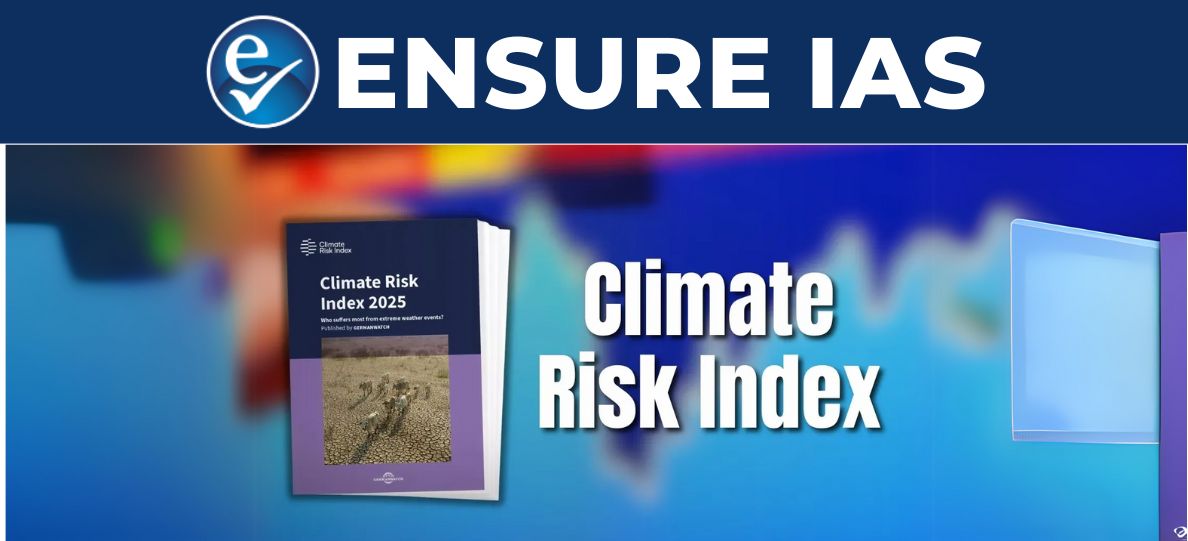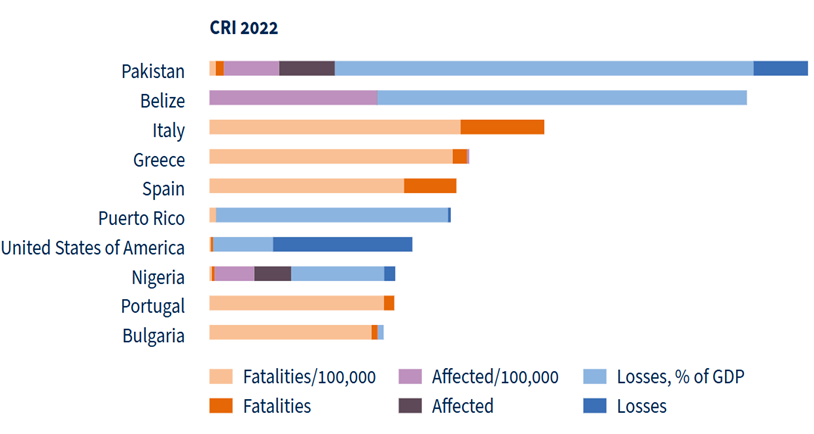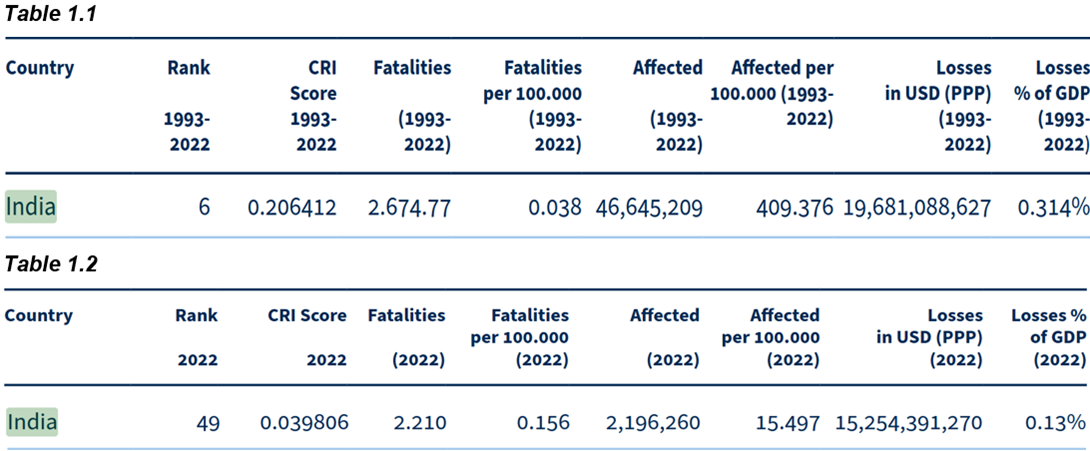- Courses
- GS Full Course 1 Year
- GS Full Course 2 Year
- GS Full Course 3 Year
- GS Full Course Till Selection
- Answer Alpha: Mains 2025 Mentorship
- MEP (Mains Enrichment Programme) Data, Facts
- Essay Target – 150+ Marks
- Online Program
- GS Recorded Course
- Polity
- Geography
- Economy
- Ancient, Medieval and Art & Culture AMAC
- Modern India, Post Independence & World History
- Environment
- Governance
- Science & Technology
- International Relations and Internal Security
- Disaster Management
- Ethics
- NCERT Current Affairs
- Indian Society and Social Issue
- NCERT- Science and Technology
- NCERT - Geography
- NCERT - Ancient History
- NCERT- World History
- NCERT Modern History
- CSAT
- 5 LAYERED ARJUNA Mentorship
- Public Administration Optional
- ABOUT US
- OUR TOPPERS
- TEST SERIES
- FREE STUDY MATERIAL
- VIDEOS
- CONTACT US
Climate Risk Index (CRI) 2025
Climate Risk Index (CRI) 2025

- The international environmental think tank ‘Germanwatch’ released the Global Climate Risk Index (CRI) 2025.
- This is the 20th Edition of the Index. It is published annually.
- The CRI, first published in 2006.
- Germanwatch, based in Bonn and Berlin (Germany), is an independent development and environmental organisation which works for sustainable global development.
- The index measures the consequences of extreme weather events on countries, including:
- Economic losses
- Fatalities (deaths)
- People affected (injured, displaced, or homeless)
- The CRI helps visualize and compare the degree of impact of extreme weather events in countries over both a 2-year period and a 30-year cumulative period. It serves to contextualize global climate policy debates and highlights countries at risk of frequent or rare extreme events.
Methodology of the Climate Risk Index
- The CRI methodology assesses extreme weather events' impact through three main categories:
- The CRI visualizes the impact of these events on countries based on:
|
Category |
Example Events |
|
Hydrological |
Flooding, landslides |
|
Meteorological |
Storms, cyclones, hurricanes |
|
Climatological |
Heatwaves, droughts, wildfires |
- Absolute impacts: Actual numbers for fatalities, affected people, and economic losses.
- Relative impacts: Impacts adjusted for the country’s size or population.
- Data for the CRI is sourced from:
- EM-DAT (International Disaster Database)
- World Bank
- International Monetary Fund (IMF)
CRI 2025 Ranking and Key Findings
- The CRI 2025 reveals an alarming trend: extreme weather events, such as heatwaves, storms, floods, and wildfires, are becoming increasingly common, leading to mounting human and economic losses. Key findings from the CRI 2025 include:
- From 1993 to 2022, over 765,000 lives were lost.
- Direct economic losses reached nearly USD 4.2 trillion (inflation-adjusted).
- Over 9,400 extreme weather events occurred globally, with increasing frequency and intensity.
This highlights the growing cost of inaction and underscores the urgent need for climate action.
- Top Affected Countries (1993–2022)
From 1993 to 2022, the countries most affected by extreme weather events are:

|
Rank |
Country |
|
1 |
Dominica |
|
2 |
China |
|
3 |
Honduras |
- Top Affected Countries in 2022
In 2022, the countries most affected by extreme weather were:

|
Rank |
Country |
|
1 |
Pakistan |
|
2 |
Belize |
|
3 |
Italy |
- Fatalities and Economic Losses (1993–2022)
- 765,000+ deaths globally.
- USD 4.2 trillion in direct economic losses (inflation-adjusted).
- Impact of Key Extreme Weather Events
From 1993 to 2022, the most significant weather impacts were:
|
Event Type |
Fatalities (%) |
Economic Losses (USD) |
|
Storms |
35% |
56% (USD 2.33 trillion) |
|
Heatwaves |
30% |
Severe impacts on ecosystems and agriculture |
|
Floods |
27% |
32% (USD 1.33 trillion) |
- Floods: Affected over 50% of people impacted by extreme weather.
India’s Ranking in CRI 1993-2022 (Table 1.1) and CRI 2022 (Table 1.2):

- India was ranked the sixth worst-affected country between 1993 and 2022 due to extreme weather events, despite improving its short-term ranking to 49th in 2022.
- The country accounted for one in ten climate-related fatalities globally during this period.
- India faces a range of increasingly frequent extreme weather events, which include: Floods, Heatwaves, Cyclones and Droughts
- Notable extreme weather events include:
- 1998 Gujarat Cyclone
- 1999 Odisha Cyclone
- Cyclones Hudhud (2014) and Amphan (2020)
- 1993 Northern India Floods
- Uttarakhand Floods (2013)
- Severe floods in 2019
- Heatwaves and Rising Temperatures: India has faced recurring and unusually intense heatwaves, with temperatures reaching around 50°C. These heatwaves have caused significant fatalities in years such as: 1998, 2002, 2003 and 2015
- Over the past three decades (1993-2022), India experienced more than 400 extreme weather events.
- These events led to economic losses of nearly USD 180 billion (adjusted for inflation).
- At least 80,000 fatalities were reported during this period due to these extreme events.
Long-Term Trends and Observations
- The CRI 2025 categorizes countries based on their exposure to extreme weather events over a 30-year period:
- Countries with highly unusual extreme events: Examples include Dominica, Honduras, Myanmar, and Vanuatu.
- Countries affected by recurring extreme events: Examples include China, India, and the Philippines.
- Climate science shows that climate change is increasing the risk of both types of events, creating a ‘new normal’ for extreme weather.
Global Impact Trends: High-Income vs. Low-Income Countries
- In 2022, seven out of the ten most affected countries were high-income nations, showing that even wealthy countries are vulnerable to extreme weather risks.
- Over the long term, Global South countries, particularly in lower-middle-income regions and Small Island Developing States (SIDS), face disproportionate impacts from climate change. These countries often have limited resources and lower coping capacities.
Challenges in Data Reporting
- The CRI ranking relies on publicly available historical data, but in many Global South countries, underreporting of extreme weather events occurs due to data quality and coverage issues.
- As a result, the true impacts in these regions may be underestimated, and the CRI ranking may not fully capture the severity of their exposure to extreme weather.
Human-Induced Climate Change
The CRI 2025 highlights that human-induced climate change is driving the increasing frequency and intensity of extreme weather events. Scientific studies show that climate change is influencing these events to such a degree that the evidence is now on par with the scientific consensus that human actions have warmed the climate.
International Policy Context: COP29 and Climate Finance
- At COP29, the international community set a target of USD 300 billion annually by 2035 for climate finance to support developing countries.
- However, this amount is viewed as the bare minimum, given the urgency of the climate challenges faced by these countries.
- Additionally, loss and damage issues were not sufficiently addressed at COP29, and there are calls for substantially increased support for the most vulnerable countries.
- Key Points from COP29:
- The USD 300 billion annual climate finance target is insufficient.
- Loss and damage were not adequately addressed.
- High-emitting countries must take greater responsibility for funding climate adaptation and mitigation efforts in vulnerable regions.
The CRI 2025 stresses the importance of ambitious climate action. Both high-income and low-income countries must ramp up their climate mitigation efforts and increase financial support for vulnerable nations. Without stronger climate action, the impacts of extreme weather events will continue to rise, affecting both the human toll and the global economy.
The CRI serves as a warning sign for countries at risk of frequent extreme events and calls for immediate and sustained action to address the escalating climate crisis.
|
Also Read |
|
| Public Administration Optional | |
| UPSC Monthly Magazine | Question Answer Practice For UPSC |




